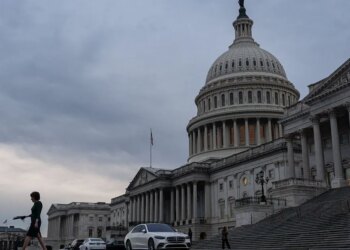President Donald Trump’s plan to shore up Republicans’ House majority in the 2026 midterm elections by redrawing congressional maps is backfiring, at least for now.
When Trump pressured Republicans in Texas and other states to carve up their districts, his party appeared to have the upper hand. They controlled the redistricting process in more states and therefore could net more seats.
But so far, Trump is losing. Democrats, who once thought they would come up short in a gerrymandering war, are on track to net an estimated five seats. And while that could shift, they may still end up with an advantage by the time state legislators, voters and courts finish weighing in.
The latest and biggest blow to Republicans came Tuesday, when a federal court wiped out a new map in Texas that could have given the GOP as many as five more House seats. That followed other setbacks in Utah, where another court ruled against Republicans, and Indiana, Kansas and New Hampshire, where Republican lawmakers so far have rebuffed pressure from the administration to redraw their maps. The string of losses is beginning to create a backlash from Trump’s allies, who want the party to focus on campaigning instead of trying to engineer new districts.
“We are relearning Newton’s third law of motion that every action has an equal and opposite reaction,” said Republican pollster and strategist Whit Ayres.
Tuesday’s ruling showed the situation is turbulent and could swing dramatically at any time. While Democrats are ahead now, they could quickly find themselves behind again.
Texas has already appealed the decision to the Supreme Court, and legislatures and courts in other states could also enter the fray and re-scramble the math. Republicans in Florida, for example, plan to redraw their map soon, which could offset the GOP losses in Texas.
But for the moment, Democrats are on a winning streak. They have drawn a new map in California that will give them as many as five more House seats. They are advancing a plan in Virginia that, if approved by voters, would give them another two or three seats. Coupled with the court win in Utah, Democrats could gain as many as nine seats across those states.
Republicans have drawn new maps in Missouri, North Carolina and Ohio that would give them as many as four more seats.
More states are likely to join the push to redraw their seats. Trump has been pressuring state leaders and threatening primaries against those who don’t fall in line. But if he succeeds in getting more Republican-led states to redraw their maps, Democratic leaders will increasingly press officials in states their party controls. That could restart another tit-for-tat cycle of cartography.
The White House did not comment, but a person familiar with GOP thinking on redistricting said the administration remains optimistic that Republicans will ultimately secure more seats through redistricting than Democrats. Republicans feel good about their chances before the Supreme Court and other courts and have already drafted litigation in case Democrats in Maryland adopt a new map there, said the person, who like some others spoke on the condition of anonymity to discuss private deliberations.
Republicans now hold a 219-214 House majority, and even a handful of changes could be the difference-maker in determining who controls the House after next year’s midterm elections. The push for new maps is unprecedented in modern politics. Ordinarily, states draw maps after each census, not in the middle of the decade, and officials in the past have not so brazenly said that the new lines were meant only to gain more political power.
Democrats, though initially reluctant, have insisted they will match every Republican maneuver.
“They started this redistricting fight,” House Minority Leader Hakeem Jeffries (D-New York) said Wednesday of Republicans. “We will end it.”
The pushback started when California Gov. Gavin Newsom (D) announced he would redraw his map in response to Texas’s new one. That showed Trump that Democrats wouldn’t be bystanders in the fight, said David Axelrod, who served as a senior adviser to President Barack Obama.
“Newsom called his bluff, and that set in motion a chain of events that are very likely to produce much different results than he thought when he started this,” he said.
Two other GOP operatives close to the Trump administration said they had long been skeptical that the redistricting push would be successful and urged their peers to remain focused on winning races that they knew would be competitive in the midterms.
“Anyone worth their salt knew not to plan until it was done,” one operative said of the redistricting effort.
“The bet was a bad bet in the first place,” a second operative said. “Just go out and win some races.”
The operatives said the White House appeared determined to see it through, even as they argued it would dilute energy that could be better spent on recruiting candidates, helping them fundraise and building enthusiasm in a tough political climate.
“There is a sense among donors that we are going to lose the majority so it makes it more difficult to raise money,” the second operative said. “There’s not a lot of energy right now. It’s just doing defense.”
Walter Olson, a senior fellow at the conservative Cato Institute, blamed tactical errors at the outset of the fight in Texas, which led to the court ruling that Republicans had likely created a map that ran afoul of the Constitution’s ban on racial gerrymandering.
“Very often the unintended consequences take years to manifest,” he said. “Seldom do they take only weeks.”
Time is running short. Candidates, voters and election officials need to know where the lines are ahead of next year’s primaries, and some states hold their primaries as early as the spring. States with later primaries have a little more room to make changes to their maps, but courts are reluctant to act the closer they get to Election Day.
The courts could play an outsize role
The Supreme Court could say within days or weeks whether it will reverse the lower court’s decision and allow the new Texas map to be used for the time being.
The justices will likely have to rule soon. Candidates face a Dec. 8 deadline for filing paperwork and they need to know where the lines are to get on the ballot. Primaries are scheduled for March.
Separately, the Supreme Court is considering a challenge to the Voting Rights Act out of Louisiana that could dramatically alter how districts are drawn in areas with large populations of Black and Latino voters. If the court rules in Louisiana’s favor, it could greatly reduce the number of Black and Hispanic majority districts and give Republicans a shot at gaining a dozen or more seats over the coming years. Whether the decision will affect the 2026 elections depends on the specifics of the ruling and when the court issues it. If the court doesn’t act until the summer, there will be little time for states to redraw their maps.
Lower courts are considering challenges to the new maps in California, Missouri and North Carolina, and how the courts rule could give one party an advantage over the other. One of the court fights will determine whether a referendum can be held to allow Missouri voters to decide whether to block the new map drawn by Republican state lawmakers.
And four voters in New York last month filed a lawsuit seeking changes to a Staten Island-based district that, if successful, could give Democrats another seat in that state.
More states could join the fight
Trump and his allies have pressured Republican officials in Indiana, Kansas and New Hampshire to redraw their maps, but so far they have rejected the efforts. The standoff in Indiana has become particularly heated in recent weeks, with Trump calling out state Senate President Pro Tempore Rodric Bray for saying he didn’t have the votes to draw a new map.
“Soon, he will have a Primary Problem, as will any other politician who supports him in this stupidity,” Trump wrote in a social media post Tuesday just before the release of the Texas decision.
Seven of Indiana’s nine districts are now held by Republicans and Bray said he believed they could win another one even without redrawing the map.
Democratic leaders, meanwhile, are urging officials in Maryland and Illinois to draw new maps despite resistance from some members of their party.
Democrats in Virginia surprised the public last month when they unveiled a plan to redraw the state’s map. They have not yet released a map and will need voter permission to adopt a new one. Their move was a reminder that new states can join the redistricting fight with little warning.
With the stakes so high, leaders from both parties are all but certain to put more pressure on their state-level allies. They also risk inspiring their opponents. When Republicans succeed in one state, Democrats in another state say they have to retaliate. When Democrats make gains in one place, Republicans urge their side to counterattack.
Kadia Goba, Marianna Sotomayor and Justin Jouvenal contributed to this report.
The post In surprise shift, Democrats are ahead in redistricting fight appeared first on Washington Post.




